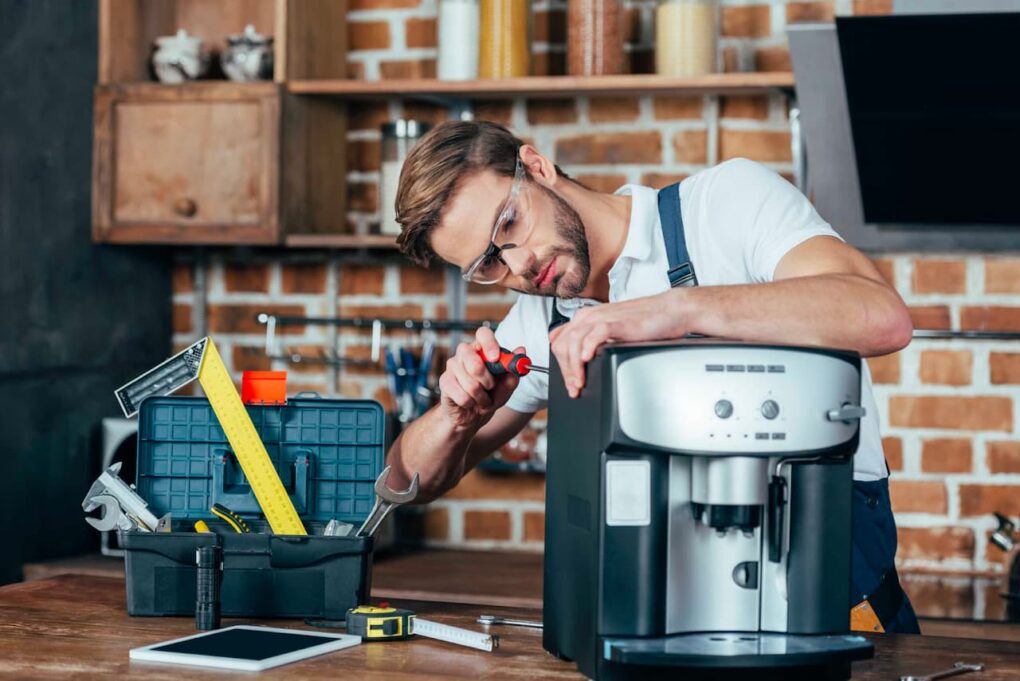A coffee maker is a great kitchen appliance that you will find in almost every home. Being an international beverage, nothing feels more refreshing than rising in the morning and smelling a fresh coffee aroma in your dining room.
Unfortunately, these are machines prone to breaking up at one time or another, but this is not a cause to worry about because appliences repairs need a simple, quick fix, and you are good to go.
How A Coffee Maker Works
Coffee makers are also known as coffee pots and are majorly used for brewing coffee. There are two types of coffee makers, which are percolator and drip. Percolator coffee makers work to continually cycle the boiling water through gravity until an optimal mixture is achieved. It is an electric-made appliance that regulates electricity for heating water through the elements used to heat water at the base.
The drip coffee makers are the modern electric appliance used in brewing coffee. It heats the water and pumps it through the drip and into the coffee basket and consequently stored in a carafe or a flask.
Problems That Arise When Using a Coffee Maker
One can experience several problems during the lifespan of a coffee maker, such as electric shorts damaging some components like switches, thermostats, timers, or electric cords. Fuses also blow, and the only way is to replace them.
Repairing a Coffee Maker
Which tools are required to repair a coffee maker? Among the tools that will do a perfect job are.
- Multimeter
- Screwdrivers
- Wrenches or bus drivers
As mentioned, coffee makers are of two types, the drip and percolator, and each follows different steps. However, the most common appliance repairs in Ajax include servicing the on/off switch, heating element, warming element, and thermostat.
But there are the first steps that are general to both types.
- Step1: Ensuring that the Coffee maker is unplugged from the electrical receptacle.
- Step 2: Disassemble the pot and the basket.
- Step 3: Turn the appliance upside down to unscrew it.
- Step 4: Check whether there are any disconnected wires or debris and fix them. Re-assemble and confirm if working.
If these general steps do not work, proceed with the procedure for the specific type of coffee maker.
Repairing a Drip Coffee Makers Thermostat
A thermostat controls how electricity will operate in a drip coffee maker, and below are the steps to follow for repair.
- Step 1: Unplug the unit from the electric receptacle and empty any excess water from the reservoir. Turn the unit downwards and unscrew it to remove the base.
- Step2: Using a multitester, test each end and confirm if the thermostat is working.
- Step3: If faulty, replace the thermostat with the same type for efficient operations.
- Step 4: Confirm if the fuse is working and replace it, and more so if the circuit was found open.
How to Repair a Percolator Thermostat
In as much as this thermostat function the same as the one for the drip. They are equally different, and below are the steps to follow.
- Step 1: Unplug the unit from the electric receptacle and turn it down to remove the base to view the thermostat.
- Step 2: Confirm if the thermostat is operational and change it if faulty, especially if it has an open circuit.

How To Service The Warming And Heating Elements
Apart from the thermostats, there is also needed to service the warming and heating elements.
Servicing the Warming Element
A warming element plays a critical role by taking a whole day long while operational and requires to be serviced as below.
- Step 1: Find the location of the warming element by removing the coffee maker’s base.
- Step2: Use a continuity tester to check if operational.
- Step 3: If faulty, replace the warming element.
How to Service the Heating Element
Everyone likes taking hot coffee, and the heating element ensures that the coffee s temperature is as required. Let’s find out how it is serviced.
- Step 1: Access the heating element through the base but ensure that any liquid is emptied before turning it down.
- Step 2: Use a multitester to check if there is any malfunction. Confirm that the element conducts electricity by testing all the terminals.
- Step 3: Replace the element if it cannot conduct electricity efficiently.
Conclusion
All these procedures are primarily DIY processes. However, if the repair requires de-soldering or un-riveting, this might be more technical, and you may need to have it done by an experienced technician. Using an appliance repair in Ajax can as well work for complete and professional repair. Go to https://plus-appliance-repair.com/appliance-repair-ajax/ and see for yourself!